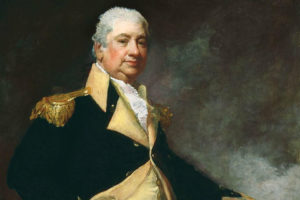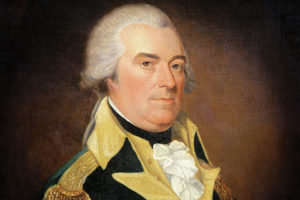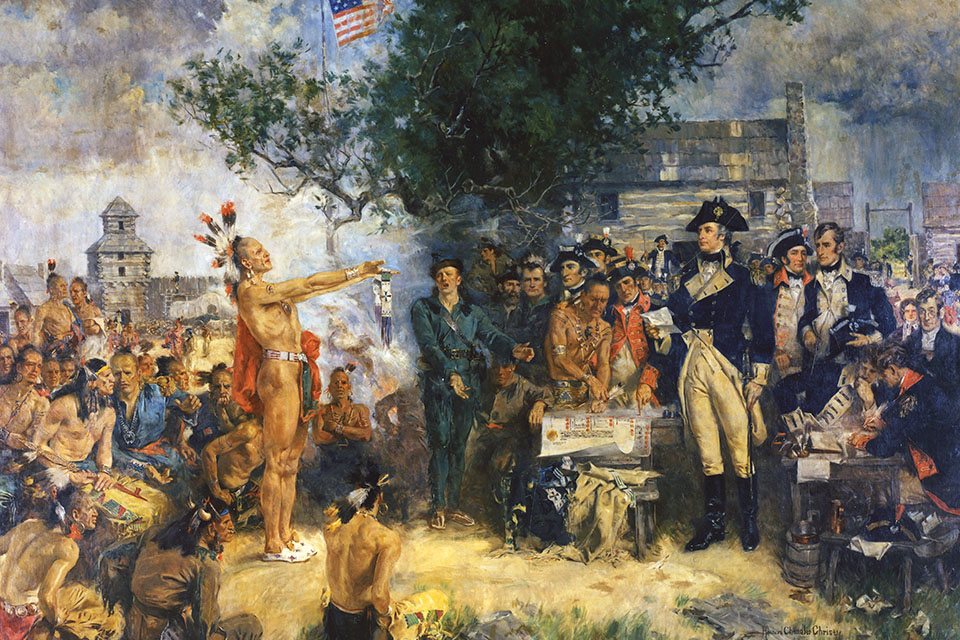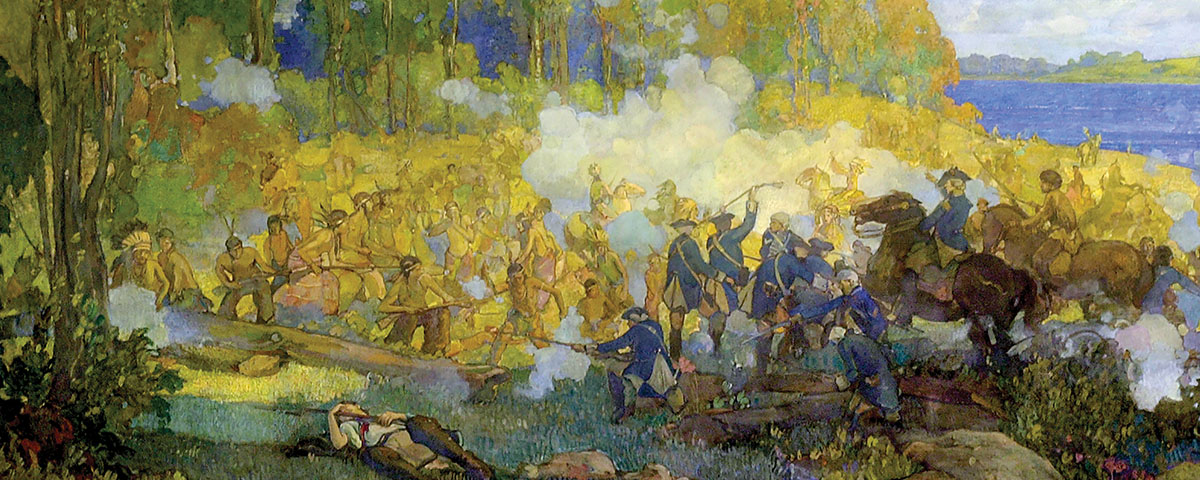In 1792 President George Washington and Secretary of War Henry Knox invented a new kind of army to fight Indians in the west. They called it the Legion of the United States.
On a frigid December evening in 1791, a messenger arrived at the Presidential Mansion in Philadelphia, where George and Martha Washington were entertaining some guests over dinner. Tobias Lear, the president’s personal secretary, sat at the table with them. The conversation was interrupted when a porter informed Lear of a visitor. Lear left the room and walked down the hall, intending to inform the man at the door that he should call at another time. But this was no inconsequential message. The uniformed officer explained nervously that he bore an urgent dispatch from Major General Arthur St. Clair, the commander of the western army.
Lear welcomed the man in and had him wait while he fetched the president. Begging his guests’ pardon, Washington excused himself from the dining room. He returned a few minutes later, apologizing for having left but making no mention as to the reason. The president seemed to enjoy the rest of his meal, and by 10 o’clock he had politely said goodbye to his guests and goodnight to his wife. Only he and Lear remained.
Washington paced back and forth across the room. Eventually he sat down on a sofa, and, his emotions visibly churning, said: “It’s all over! St. Clair’s defeated—routed; the officers nearly all killed.” The president suddenly rose from his seat, took a few steps, and then erupted in an anger that Lear had never before witnessed. “Here on this very spot I took leave of him! I wished him success and honor; you have your instructions, I said, from the secretary of war, and I will add but one thing—beware of a surprise. I repeat it, beware of a surprise! You know how the Indians fight us. And yet, to suffer that army to be cut to pieces, hacked, butchered, tomahawked, by a surprise—the very thing I guarded him against! Oh God, oh God, he’s worse than a murderer. How can he answer it to his country?”
The cause of Washington’s distress? In the early hours of November 4, the United States’ only standing army had been nearly destroyed by Indian warriors in the Northwest Territory—a vast region north of the Ohio River, east of the Mississippi River, and southwest of the Great Lakes. It was an unmitigated military disaster, and it was up to Washington and his secretary of war, Henry Knox, to recover and retaliate. The government’s heavy reliance on paid-by-the-day militiamen, both of them realized, would no longer do.
Their response to St. Clair’s defeat and the Indian menace—fueled by support from Britain—would be a pivotal moment in U.S. military history. Washington and Knox designed, from scratch, a new army—a modern reinvention of the famous Roman Legion of antiquity. The product of classical military theory adapted to contemporary American conditions, it was called the Legion of the United States.
After the American victory in the Revolutionary War, the 1783 Treaty of Paris explicitly stated that Britain was to evacuate the Northwest Territory—also known as the Ohio country—and cede it to the United States. But in a clear breach of the treaty, the British kept their forts and forces in Detroit, Michilimackinac, Niagara, Oswego, and Presque Isle, and from these positions armed and instigated the Miami, Shawnee, Delaware, Ottawa, Kickapoo, and Illinois tribes to attack the American settlers moving into the region. Indian war parties slaughtered some 1,500 men, women, and children in the Northwest Territory, and the calls for vengeance steadily intensified.
Born in Scotland, Arthur St. Clair had served in the British Army during the French and Indian War before settling in Pennsylvania and rising in rank to major general in the Continental Army. A friend of Washington’s, St. Clair had secured the governorship of the Northwest Territory through his tenure as president of the Continental Congress in the years immediately preceding the Constitutional Convention. He had succeeded Josiah Harmar as commander of the U.S. army in the Northwest Territory after an ill-conceived punitive campaign against the Indians along the Indiana-Kentucky border ended in defeat in 1790. Determined to wrest control of Ohio from the Indians, St. Clair prepared for another expedition into the territory.
St. Clair gathered a little more than 1,000 soldiers—two understrength infantry regiments—and nearly 300 militiamen to disperse the buildup of Indian warriors and British agents in Indiana near Kekionga, one of the Miami villages. They brought along more than 200 of their wives and children and hundreds of livestock. From Fort Washington at Cincinnati the column slowly moved north, pausing for weeks to build Fort Hamilton, north of Cincinnati, and Fort Jefferson, near present-day Darke County. Discipline was nearly nonexistent, morale pitiful. Many of the soldiers had been recruited from the streets and jails of the nation’s eastern cities and had not been trained to follow orders or even fire their weapons, let alone fend off Indian assaults. Desertion was a major problem. Nearly a quarter of the entire force vanished before any hostilities; one group of deserters even plotted to plunder their own army’s supply train.
On the night of November 3, 1791, St. Clair’s motley army was bivouacked without adequate defenses, and soon paid the price for its carelessness. The army made camp near the headwaters of the Wabash River, with only a few sentries posted. Some 1,000 to 1,500 Indian warriors, led by Miami chieftain Little Turtle, slowly encircled the unaware Americans. Lieutenant Ebenezer Denny, who served as St. Claire’s aide-de-camp, would later write in his diary that the Indians “seemed to brave everything, and when finally fixed around us, they made no noise other than their fire, which they kept up very constant.”
What transpired at St. Clair’s unfortified camp could hardly be called a battle. Of the 52 officers present, 39 were killed and seven wounded. Of the 920 enlisted, only 24 soldiers would emerge unhurt. Scores of women and children were also killed, while Indian casualties were negligible. In terms of casualties, it was the army’s worst defeat to date at the hands of Indians.
While St. Clair managed to escape to Cincinnati on one of the few surviving horses, his army had been utterly destroyed. Weeks later the calamitous news reached the president. St. Clair was eventually cleared of wrongdoing by Congress, but his military career was over.
As the news of St. Clair’s defeat reached the capital, a pantribal council of Indians was meeting to decide whether to continue waging the ad hoc war against settlers or to pursue terms of peace from a position of strength. The council disbanded for the winter without having reached a decision. While Indian forces made several raids on Fort Jefferson in 1792, the Indian confederacy remained largely inactive militarily, and a temporary peace held as the pantribal council debated the situation through most of 1793.
Taking advantage of the brief cessation in hostilities, Washington began building a real army. He had long wanted a standing army, a peacetime force of 3,000 men, but Congress, which just 10 years earlier had called such an army “dangerous to the liberties of a free people” and wary of imposing the taxes needed to pay for one, had foiled him at every turn. But with St. Clair’s defeat the opportunity for a new military approach presented itself, and Washington and Knox seized it.
Henry Knox had been one of Washington’s most capable lieutenants during the Revolution. But now, as secretary of war, he was navigating a treacherous political and military landscape. Britain continued to violate American sovereignty, disagreement and turmoil divided the founders, and Indians raided with impunity along the frontier.
Knox had a clear vision of how the government should respond to St. Clair’s defeat. Years earlier, as a Boston bookseller, he had immersed himself in the literature

of war, to the point that he could accurately be described as a scholar of military strategy and tactics. For political theorists, Rome served as both an inspiration and a cautionary tale. But for Knox, the Roman Legion was the progenitor of army organization. The French political philosopher Montesquieu wrote that “the main reason for the Romans becoming masters of the world was that, having fought successively against all peoples, they always gave up their own practices as soon as they found better ones.” Knox certainly agreed; he saw the Roman Legion’s success as a mark of its syncretic abilities, which, now that he was secretary of war, he hoped to emulate in the form of a “Legion of the United States.”
Knox was far from alone in his admiration of the Roman Legion. While fascination with the Roman war machine went back centuries, the study of classical military theory reached new heights during the Enlightenment. One of the greatest of the 18th-century visionaries was Maurice de Saxe, an eccentric French general and military theorist. Born in 1696, Saxe was one of the 354 acknowledged illegitimate children of Augustus II (Augustus the Strong), king of Poland and elector of Saxony. A career mercenary, Saxe settled permanently into French service, and in 1743 King Louis XV named him marshal of France.
Saxe’s successful military career culminated in Mes Rêveries, a stunningly original treatise on the science of war that was published posthumously in 1757. Written in 13 nights in 1732 while Saxe was sick with fever, Rêveries advanced weapon technology, adapted existing battle formations, and reintroduced a military practice that had been lost since the Romans: marching in cadence. As one of the first true proponents of combined-arms doctrine, Saxe suggested grouping all combat arms—infantry, cavalry, artillery—in multiple standardized units that he called legions. It is no coincidence he chose that name. “The Romans vanquished all nations by their discipline,” he wrote. “Their legion was a body so formidable as to be capable of undertaking the most difficult enterprises.”
Knox drew on the writings of two contemporary military leaders with personal connections to Washington—Henry Bouquet and Friedrich Wilhelm, Baron von Steuben—for additional inspiration.
Bouquet, born in Switzerland in 1719, served in the Dutch and Sardinian armies before being granted a commission in the British Army. Deployed to North America in 1756, he fought in the campaign to capture Fort Duquesne during the French and Indian War but rose to greater prominence in its aftermath, as Indian tribes from the Great Lakes region and the Ohio River Valley challenged British colonization in North America. In 1763, in what would become known as Pontiac’s War, a loose confederation of tribal factions launched attacks on British forts and settlements west of the Appalachians. As Bouquet’s column marched to relieve the besieged Fort Pitt in western Pennsylvania, several hundred Indian warriors attacked. Bouquet’s men fought them off, with minor casualties, and continued on to end the siege.
In 1764 Bouquet published Reflections on the War with the Savages of North America, which he intended to serve as a blueprint for future Indian wars. In it he discusses the American terrain, the nature of Indian tactics, and the ideal military unit to take advantage of both. Calling the Romans “our masters in the art of war,” Bouquet proposed a mobile combined-arms unit that would replicate the Roman Legion’s flexibility and hitting power. The treatise was the last of Bouquet’s contributions to 18th-century warfare, as he died a year later from yellow fever.
But it was Steuben, Washington’s famous drillmaster, whose Letter on the Subject of an Established Militia, and Military Arrangements, Addressed to the Inhabitants of the United States influenced Knox the most. In his essay Steuben explained why a combined-arms adaptation of the Roman Legion, as both Saxe and Bouquet had proposed, was the ideal structure for the American military. As Steuben saw it, each unit, being a self-contained army of all arms, could begin operations at a moment’s notice and respond to every species of war. Steuben’s treatise was mostly ignored after it was published in 1784. Few in Congress wanted a professional military establishment, especially since memories of abuse by British regulars were so fresh in the minds of their constituents. That attitude changed, however, the moment St. Clair’s army was decimated at Wabash. The idea of a flexible, combined-arms force that could effectively fight the Indians finally started taking hold.
Soon, Congress agreed to let Washington and Knox have their way, authorizing the president to restructure the nation’s military as he deemed “expedient” until “the United States shall be at peace with the Indian tribes.”
On December 27, 1792, the U.S. Army was reorganized as the Legion of the United States. Washington and Knox incorporated everything they had learned into the new fighting force. From Rome they took logical structure and the power of adaptable, standardized units. From Saxe they took the combined-arms concept, from Bouquet mobile, open-order formations designed for the American terrain. In reforming the army, Washington and Knox abandoned the traditional regimental structure. Instead of relying on large regiments of infantry, cavalry, or artillery, the Legion of the United States was a single cohesive unit made up of four self-contained armies. The armies, called sublegions, each contained 1,280 soldiers, with two infantry battalions, one rifle battalion, an artillery company, and a cavalry company.
Although conventional European-style regiments may have been effective when massed in huge armies on open terrain, they were wholly ineffective when traversing the American wilderness and battling irregulars. The Legion attempted to address the failures of regimental design while underscoring the benefits of each combat arm. The result was an adaptable, standardized force of 5,120 men—exactly the size of the famed legions of Julius Caesar.
But who was the right man to lead the new legion? At the top of Washington’s list was Charles Coatesworth Pinckney of South Carolina. Pinckney had turned down Washington’s two previous offers to join his cabinet, but the fact that he had never commanded men in the field ultimately disqualified him.
After ruling out 15 others, Washington selected Anthony Wayne, the last man on his list, to command the Legion.

Nicknamed “Mad Anthony” for his brutal, bayonets-only night attack on a British garrison at Stony Point, New York, in 1779, Wayne was known for his coolness under fire and his ability to inspire his men. Despite his volatile temper and sense of invincibility, Wayne was supremely loyal—something Washington needed. But Wayne had struggled to find his place after the war. He won a seat in Congress but was forced out amid allegations of voter fraud. Nonetheless, Washington believed that Wayne was the right man for the job of confronting the Indians to the west. The letter that arrived asking him to take command of the Legion was a lifeline. Wayne once again had a purpose.
By November 1792, even before Congress had officially approved Washington’s plans, Wayne was drilling his legionaries in western Pennsylvania. The new army was beginning to take shape. In adapting to the irregular forest fighting that he knew was to come, Wayne required that musket cartridges contain a ball and at least three small buckshot, and he issued improved, faster-firing muskets to his riflemen.
It was clear that Wayne, a professional soldier, meant business. He ordered seven deserters executed, and those who had committed smaller offenses—falling asleep on duty, for example, or marching in soiled uniforms—were lashed or cashiered.
Wayne even set up mock combat exercises, having some of his men strip off their shirts, streak their bodies and faces with war paint, and whoop as they “attacked” by firing blank cartridges.
As the legion was drilling in the fields of Pennsylvania, the briefly held peace between the U.S. government and the Indian confederacy began to come apart. Aware that Wayne’s forces had landed by boat in Cincinnati, the Indians accused their adversaries of speaking “with a double tongue,” and perhaps they were. While the government negotiators were talking peace, Wayne and his men were preparing for war.
In 1793 disagreements within the Indian confederacy had broken out as representatives of the various tribes debated the U.S. government’s representatives at the peace conference known as the Grand Council on the Sandusky River. The Shawnee and Delaware insisted that the United States acknowledge the Treaty of Fort Stanwix, which in 1768 had set the Ohio River as the boundary of the United States, and argued that U.S. land claims were based on treaties with Indian nations that did not live there. But the tribes couldn’t agree on how to pursue a peace. Joseph Brant, a Mohawk military and political leader, argued that the tribes had nothing to gain from the Stanwix treaty and should not concede the Ohio River boundary. Meanwhile, the government proposed that the tribes relinquish their rights to the lands at issue, sparking outrage among the Indians and triggering renewed fighting in the territory.
This time, however, the U.S. military forces under Wayne would be ready.
Wayne, noting that he was under orders from Knox and Washington to “make those audacious savages feel our superiority in Arms,” had whipped his men into shape with months of rigorous preparation. He’d started training his men at Fort Fayette, near the town of Pittsburgh, but moved them 22 miles down the Ohio River after concluding that Pittsburgh was nothing less than “a frontier Gomorrah.” He christened the new camp Legionville and amped up his training regimen, using Steuben’s Blue Book, the legendary drill manual from the Revolutionary War.
In the spring of 1793 the Legion marched to a staging ground near Cincinnati and from there methodically advanced north. St. Clair had left his flanks unprotected, but now, in keeping with Roman practices, Wayne’s men built fortified camps each night. The camps served the dual purposes of defending against surprise attacks and laying the infrastructure for a major military road. On Christmas Eve 1793 the men reached the site of St. Clair’s defeat two years earlier and began the construction of what Wayne christened Fort Recovery. They also scoured the area for abandoned supplies and proceeded to bury the skeletons that were spread across the battlefield.
The new year brought intermittent attacks on Wayne’s convoys—the largest just outside the gates of Fort Recovery on June 30, 1794. Some 2,000 Indians, led by the Shawnee war chief Blue Jacket, attacked Major William McMahon’s supply column, along with approximately 90 riflemen and 50 dragoons. McMahon’s men hastily retreated to Fort Recovery, but not before 32 of them were killed and another 30 wounded. A full-scale attack on the fort followed, but after two days the Indians retreated. The next two months saw additional skirmishes, as the final battle for the Ohio territory loomed.
What would become known as the Battle of Fallen Timbers broke out on August 20, 1794. Named for clearing in a heavily forested area near the lower Maumee River, the action began with an Indian charge against the legion’s vanguard, which immediately fell back to join the advancing sublegions.
Now, the full force of the Legion of the United States was brought on the enemy. Unleashing an initial volley, the legionaries then fixed bayonets and launched a countercharge. After 45 minutes of fierce hand-to-hand fighting the Indians retreated to Fort Miami, a British garrison with 400 redcoats. The British officer at the fort refused to let the fleeing Indians in, and the remaining resistance swiftly collapsed.
The legion’s decisive victory at Fallen Timbers opened the way for white settlements throughout Ohio and the rest of the lower Great Lakes region. With Wayne and his men remaining in Ohio after the battle, Indian resistance dissipated and then disappeared. But perhaps even more significant was Britain’s withdrawal from the area in the face of the American show of power. After years of providing arms and other support to Indian tribes, Britain began abandoning its forts in U.S. territory. Thus, for the United States, the Northwest Indian War of 1794 brought not only victory over Indian tribes going to war over their ancestral lands but a final victory over Britain.
Several years before he became president, Theodore Roosevelt would call Wayne’s victory “one of the most striking and weighty feats in the winning of the West.” In his 1896 book, The Winning of the West, Roosevelt wrote:
The battle of the Fallen Timbers opened the eyes of the Indians to the fact that, though the British would urge them to fight, and would secretly aid them, yet in the last resort the King’s troops would not come to their help by proceeding to actual war. Accordingly, all their leaders recognized that it was time to make peace.
In January 1795 representatives from the various tribes met with Wayne at Fort Green Ville. They spent the next eight months hammering out the terms of an agreement that called for the Indians to relinquish all claims to large swaths of modern-day Ohio and parts of Illinois and Michigan in exchange for “annuities”—grants of federal money and supplies such as blankets, utensils, and domestic animals.
On August 3, 1795, leaders of 12 Indian tribes formally signed the Treaty of Greenville. A few months later the British agreed to abandon all the forts they had established on U.S. territory.

In the years immediately following the Battle of Fallen Timbers, the Legion of the United States lapsed into American lore. All four of its chief proponents were gone. Steuben had died in November 1794 at his estate in Oneida County, New York. Knox had left government service in January 1795 and returned to his home in Thomaston, Maine; he died in 1806 after swallowing a chicken bone. Washington, near the end of his second term of president, had bid farewell to his “friends and fellow-citizens” in September 1796 and retired to his home at Mount Vernon in Virginia; he died there three years later. As for Wayne, he had died of complications from gout in December 1796 during a return trip to Pennsylvania from a military post in Detroit.
Wayne’s second in command, Brigadier General James Wilkinson, succeeded him as senior officer of the U.S. army. Wilkinson had been openly contemptuous of Wayne, criticizing his actions during the Battle of Fallen Timbers and proceeding to file formal complaints against Wayne afterward. Wayne fought back by launching an investigation into Wilkinson’s relationship with the Spanish government—for whom he was spying, it turned out—and attempting to court-martial him.
With Wayne gone, Wilkinson immediately set about dismantling the legion that he had led. When a tightfisted Congress sharply reduced the size of the army, Wilkinson ordered the four sublegions that had served under Wayne to be folded into the 1st, 2nd, 3rd, and 4th Regiments of the U.S. Army. And so the Legion of the United States disappeared, never to be resurrected.
In his 1973 classic, The American Way of War: A History of United States Military Strategy and Policy, historian Russell F. Weigley called Wayne “the father of the regular army.” No doubt he was. He and the legion he commanded changed the course of American history not only at Fallen Timbers but today, more than 200 years later, may continue to do so as the U.S. Army more aggressively embraces expeditionary warfare. MHQ
Brandon Quintin, a former editorial assistant at MHQ, works for the Heritage Museum in Dayton, Virginia.





